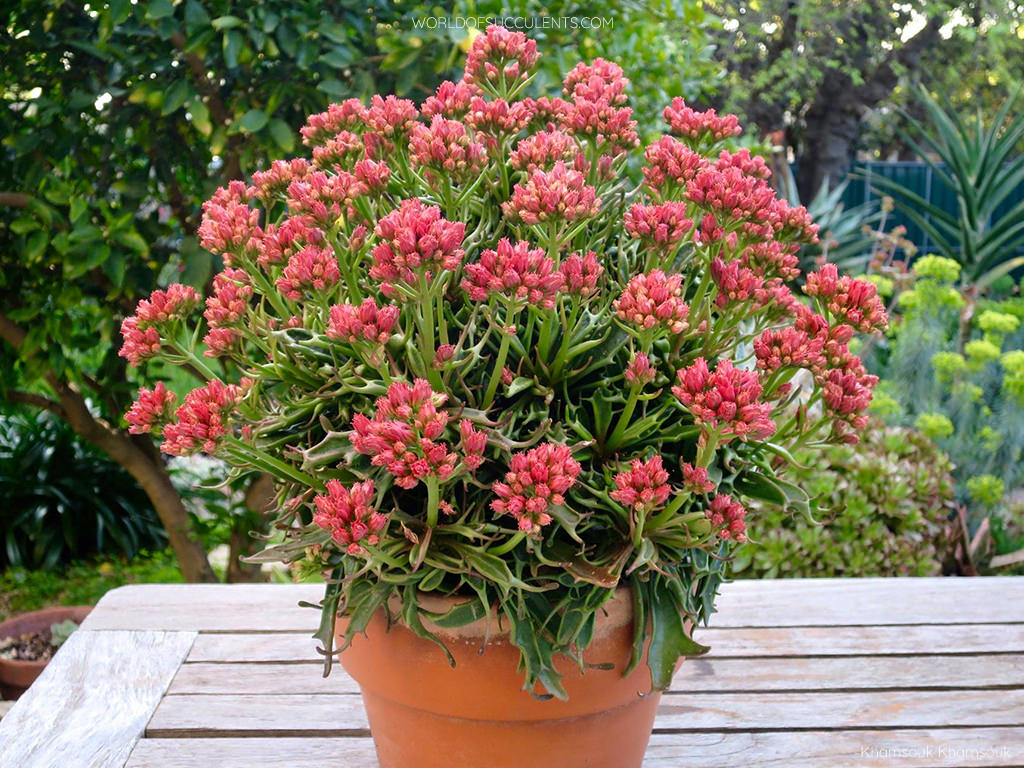Scientific Name
Kalanchoe 'Tarantula'
Synonym(s)
Kalanchoe 'Katapifa'
Scientific Classification
Family: Crassulaceae
Subfamily: Sedoideae
Tribe: Kalanchoeae
Genus: Kalanchoe
Origin
This succulent is a product of a breeding program conducted by Leonardus Johannes Maria van der Knaap in Naaldwijk, The Netherlands. It was discovered and selected in 2007 and patented (PP24253) in 2014 under the name Kalanchoe 'Katapifa' but is usually sold as Kalanchoe 'Tarantula' or Kalanchoe katapifa 'Tarantula'.
Description
Kalanchoe 'Tarantula', also known as Kalanchoe 'Katapifa', is a bushy succulent with branches that bear irregular, green, spidery leaves, hence the name "Tarantula." It grows up to 12 inches (30 cm) tall, nearly equal in diameter, freely branching and forming a rounded crown. Leaves are fleshy, smooth, irregularly ovate to lanceolate with deeply serrated margins, up to 4 inches (10 cm) long and 2 inches (5 cm) wide. The long-lasting double flowers are vibrant pink to red and appear in dense clusters from spring through fall. This plant has a freely flowering habit, with about 50 flowers developing per inflorescence.

How to Grow and Care for Kalanchoe 'Tarantula'
Light: K. 'Tarantula' grows best in full sun but usually appreciates some partial shade in the heat of the day. Indoors, place your plant near a window that receives indirect sunlight. It will stretch if it does not have enough light.
Soil: As with most succulents, K. 'Tarantula' does not like "wet feet" and needs soil that drains well. Commercial potting mixes for succulent plants will work fine.
Temperature: This plant thrives in heat and humidity but is intolerant to frost. K. 'Tarantula' can withstand temperatures as low as 30 °F (-1.1 °C). USDA Plant Hardiness Zones 10a to 11b, 30 to 50 °F (-1.1 to 10 °C).
Watering: From spring to fall, water thoroughly, but let the soil dry between watering as overwatering may cause stem rot. Reduce water during the winter months. Water your plant just enough to prevent the leaves from shriveling.
Fertilizing: K. 'Tarantula' benefits from occasional fertilizing during the growing season. Use a balanced fertilizer diluted to half or quarter strength applied every two weeks.
Repotting: This plant thrives better when it is frequently repotted, as this encourages new growth and health. For optimum growth, repot them every two years in spring. Go up one pot size every time you repot.
Propagation: Propagate by stem cuttings. Spring is the best time to take cuttings.
Learn more at How to Grow and Care for Kalanchoe.
Toxicity of Kalanchoe 'Tarantula'
K. 'Tarantula' is not toxic to people but should be kept away from pets because it may cause vomiting, diarrhea, and heart arrhythmias if consumed.
Links
- Back to genus Kalanchoe
- Succupedia: Browse succulents by Scientific Name, Common Name, Genus, Family, USDA Hardiness Zone, Origin, or cacti by Genus
Photo Gallery
Click on a photo to see a larger version.


